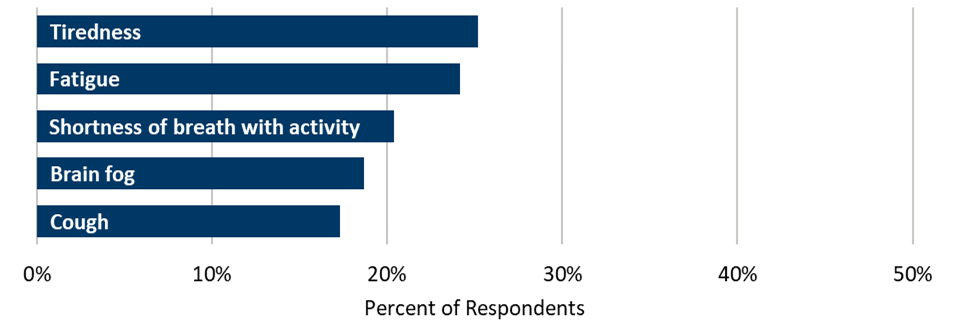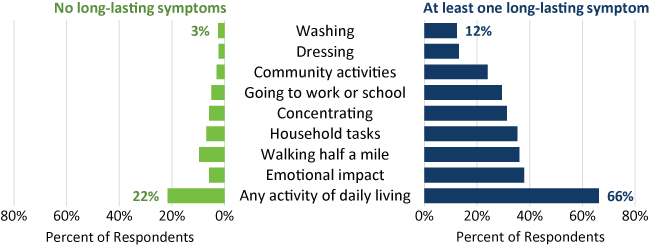Long COVID Data and Reports
Impact of Long COVID Symptoms in Minnesota
Download a PDF version of this webpage: Impact of Long COVID Symptoms in Minnesota (PDF)
In 2023, the Minnesota Department of Health (MDH) called 20,000 adult Minnesotans with a known COVID-19 infection to learn about symptoms and experiences occurring three months or more after their infection. A total of 1,270 people completed the interview. Due to low participation and other survey limitations, the survey cannot tell us the prevalence of long COVID, nor does this group represent all Minnesotans experiencing lasting symptoms after a COVID-19 infection. Nonetheless, their input can help the public, health care providers, and public health professionals understand long COVID symptoms and how they can impact a person’s daily activities and health care experiences.
What is long COVID?
Long COVID refers to infection-associated chronic conditions that can happen after having COVID-19. Many symptoms have been reported, but some of the most common include fatigue, brain fog, extreme tiredness after activity, headaches, muscle pain, change in taste or smell, and shortness of breath. Some people with long COVID have mild to moderate symptoms that gradually get better after a few months. Others have more severe or even debilitating symptoms that can last for several months or years. Findings from the 2023 National Health Interview Survey (NHIS) indicated that 8.4% of adults reported ever having experienced long COVID. This suggests that an estimated 365,000 adults in Minnesota could have experienced symptoms of long COVID.
What did the survey find?
Long COVID symptoms reported by Minnesotans
Over 40% of the survey respondents reported having at least one symptom lasting three months or longer after they had COVID-19. Many experienced symptoms lasting six months or longer. Approximately 1 in 5 respondents had a long-lasting symptom that was severe.
The most common long-lasting symptoms were tiredness, fatigue, shortness of breath, brain fog, and cough.

Other commonly reported symptoms included muscle pain, sleep difficulty, headaches, joint pain, and loss of smell or taste. The most common symptoms reported were similar no matter the person’s age, gender, race, or ethnicity.
Nearly half of those who experienced a long-lasting symptom said they had visited a health care provider about a new health issue after their COVID-19 infection, however, only 9% were told by their provider that they may have long COVID. A 2023 poll from the de Beaumont Foundation found that only 7% of physicians felt very confident diagnosing long COVID and only 4% felt very confident treating long COVID.
Long COVID symptoms impact daily life
Two-thirds of those with long-lasting symptoms said they had difficulty performing daily activities, such as household tasks or going to work or school.
People with long-lasting symptoms reported more difficulty with activities of daily living.

Fewer long COVID symptoms with more complete COVID-19 vaccination
Respondents who completed the primary COVID-19 vaccination series and had received one or more booster vaccines reported 16% fewer long COVID symptoms compared to respondents who were unvaccinated. This is similar to trends seen in recent national studies.
People who were vaccinated at the time of their first infection were less likely to report long-lasting symptoms than unvaccinated respondents.
COVID-19 Vaccination Status

What can I do to prevent long COVID?
The best way to prevent long COVID is to avoid getting infected or re-infected with the virus that causes COVID-19. Additional protective measures include:
- Getting an updated COVID-19 vaccine.
- Practicing good hygiene, including washing your hands and covering your cough.
- Taking steps for cleaner air, like opening windows, using filtration, or holding gatherings outside.
- Wearing a mask or keeping physical distance during viral respiratory illness season.
What should I do if I think I have long COVID?
Start by talking with a doctor or health care provider about your symptoms.
What is MDH doing to address long COVID?
MDH is one of the first state health departments in the country to have a program and staff dedicated to long COVID. Work includes:
- Raising awareness about long COVID and creating informational resources.
- Implementing an ongoing statewide survey to monitor long COVID symptoms and similar conditions in Minnesotans who had COVID-19 or other infections.
- Conducting a statewide study across 12 health systems that provide services to over 90% of Minnesota’s population to recognize and describe patients experiencing long COVID symptoms. This can help improve diagnosis and care practices, especially among underserved patient populations.
- Convening the Long COVID Guiding Council of clinical professionals from 14 organizations, including major health systems, Federally Qualified Health Centers, the Veterans Administration, and the Minnesota Department of Human Services.
- Providing funding to 18 community partner organizations that serve disabled, myalgic encephalomyelitis/chronic fatigue syndrome (ME/CFS), low-income, rural, American Indian, Latine, African American, African immigrant, Asian American, Asian immigrant, and LGBTQ+ communities throughout Minnesota. These organizations reach thousands of individuals disproportionately impacted by the COVID-19 pandemic. They are helping us to understand the impacts of long COVID, raise awareness, and increase access to quality care and support for long COVID and related conditions.
- Serving as national leadership on committees and workgroups for:
- The Centers for Disease Control and Prevention
- The U.S. Department of Health and Human Services Office of Long COVID
- The Agency for Healthcare Research and Quality
- The Association of State and Territorial Health Officials
- The Council for State and Territorial Epidemiologists
- The National Association of Chronic Disease Directors
For more information on our current projects, collaborations, and resources, visit the MDH Long COVID Program webpage.
References